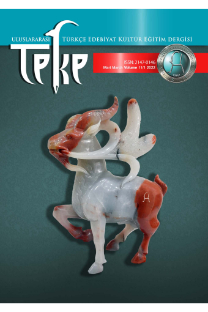MÜLTECİ ÇOCUKLARA İLİŞKİN TÜRKİYE’DE YAPILAN TEZLERİN İNCELENMESİ
Mülteci çocuk, Lisansüstü tezler, Türkiye, doktora tezler, yüksek lisans tezler, tez inceleme
THE ANALYSIS OF THE GRADUATE THESES RELATED TO REFUGEE CHILDREN IN TÜRKİYE
refugee children, dissertations, Türkiye, doctoral dissertations, master’s thesis, theses examination,
___
- Alkar, E. ve Atasoy, E. (2020). Türkiye’de göç üzerine yapılan doktora tezlerine yönelik bir içerik analizi. TESAM Akademi Dergisi, 7(1), 67-89. doi:10.30626/tesamakademi.696174
- Akpınar, T. (2017). Türkiye’deki Suriyeli mülteci çocukların ve kadınların sosyal politika bağlamında yaşadıkları sorunlar. Balkan ve Yakın Doğu Sosyal Bilimler Dergisi, 3(3), 16-29.
- Altındiş, M. (2013). Türkiye’de mülteciler, salgın hastalıklar ve korunma. Sağlık Düşüncesi ve Tıp Kültürü Dergisi, 28, 64-67.
- Angel, B., Hjern, A. & Ingleby, D. (2001). Effects of war and organized violence on children: A study of Bosnian refugees in Sweden. American Journal of Orthopsychiatry, 71(1), 4-15. doi:10.1037/0002-9432.71.1.4
- Apak, H. (2018). Türkiye’de sosyal hizmet lisansüstü tezlerinin göç bağlamında değerlendirilmesi, Kadim Akademi SBD, 2(2), 123-135.
- Başar, M., Akan, D. ve Çiftçi, M. (2018). Mülteci öğrencilerin bulunduğu sınıflarda öğrenme sürecinde karşılaşılan sorunlar. Kastamonu Education Journal, 26(5), 1571-1578. doi:10.24106/kefdergi.427432
- Betts, A. ve Kaytaz, E. (2009). National and international responses to the Zimbabwean exodus: Implications for the refugee protection regime. New Issues in Refugee Research, Research Paper No. 175. July. UNHCR.
- Bloor, M. & Wood, F. (2006). Keywords in qualitative methods: A vocabulary of research concepts. Londra: Sage.
- Bozkaya, H. (2021). Göç ve göçmenlerin eğitimi ile ilgili Türkiye’deki doktora tezlerinin incelenmesi: bir içerik analizi çalışması. Milli Eğitim Dergisi, 50(1), 1013-1030. doi:10.37669 millieğitim.960008
- Collet, B. (2010). Sites of refuge: Refugees, religiosity, and public schools in the United States. Educational Policy, 24(1), 189–215.
- Çelebi, C., Ergül, E., Usta, B. ve Mutlu. M. (2019). Türkiye’de yabancılara Türkçe öğretimi alanında hazırlanmış lisansüstü tezler üzerine bir meta-analiz çalışması. Temel Eğitim Dergisi, 1(3), 39-52.
- Çolak, İ. ve İşeri, E. T. (2022). Okul yöneticilerine göre sığınmacı öğrencilerin eğitim sorunları. Uluslararası Türk Eğitim Bilimleri Dergisi, 2022(18), 93-113. doi:10.46778/goputeb.1027707
- Dalhouse, D. W. & Dalhouse, A. D. (2009). When two elephants fight the grass suffers: Parents and teachers working together to support the literacy development of Sudanese youth. Teaching and Teacher Education, 25, 328–335. doi:10.1016/j.tate.2008.07.014
- Hart, C. (2000). Doing a literature review.releasing the social science research imagination. London: SAGE Publications.
- Hodes, M. (2000). Psychologically distressed refugee children in the United Kingdom. Child Psychology & Psychiatry Review, 5(2), 57–68. doi:10.1017/S136064170000215X
- Karasar, N. (1994). Bilimsel araştırma yöntemi: Kavram, ilkeler, teknikler. 3A Araştırma Eğitim Danışmanlık.
- Kardeş, S. (2021). Türkiye’de eğitim alanında mültecilerle ilgili yapılan lisansüstü tezlerin incelenmesi. Milli Eğitim Dergisi, 50(1), 837-855. doi:10.37669/milliegitim.882612
- Lee, M., Wu, T., & Tsai, C. (2009). Research trends in science education from 2003 to 2007: A content analysis of publications in selected journals. International Journal of Science Education, 31(15), 1999-2020. doi:10.1080/09500690802314876
- McKenzie, D., & Rapoport, H. (2011). Can migration reduce educational attainment? Evidence from Mexico.Journal of Population Economics, 24(4), 1331-1358. doi:10.1007/s00148-010-0316-x
- Merriam, S. B. (1988). Case study research in education: A qualitative approach. San Francisco, CA, US: Jossey-Bass.
- Oikonomidoy, E. (2010). Zooming into the school narratives of refugee students. Multicultural Perspectives, 12(2), 74-80. doi:10.1080/15210960.2010.481186
- Paksoy, S. ve Karadeniz, M. (2016). Kilis'te çalışan Suriyeli sığınmacıların sosyoekonomik yapısı üzerine bir araştırma. Electronic Journal of Social Sciences, 15(58). doi:10.17755/esosder.81867
- Patiadino J. M. (2008). Identifying a theoretical perspective to meet the educational needs of twice-migrated sudanese refugees. Journal of Ethnographic & Qualitative Research, 2, 197-204.
- Rah, Y., Choi, S., & Nguyễn, T. S. T. (2009). Building bridges between refugee parents and schools. International Journal of Leadership in Education, 12(4), 347-365. doi: 10.1080/13603120802609867
- Roxas, K. (2010). Who really wants “the tired, the poor, and the huddled masses” anyway?: Teachers’ use of cultural scripts with refugee students in public schools. Multicultural Perspectives, 12(2), 65-73. doi:10.1080/15210960.2010.481180
- Roxas, K. (2011). Tales from the front line: Teachers’ responses to Somali Bantu refugee students. Urban Education, 46(3), 513-548. doi:10.1177/0042085910377856
- Salı, G. ve Şeker, S. (2023). Mülteci öğrencilerin eğitim sorunlarının incelenmesi: Yozgat ili örneği. Bolu Abant İzzet Baysal Üniversitesi Eğitim Fakültesi Dergisi, 23(2), 977-1004. doi:10.17240/aibuefd.2023...-881054.
- Sarıer, Y. (2020). Türkiye’de mülteci öğrencilerin eğitimi üzerine bir meta-sentez çalışması: sorunlar ve çözüm önerileri. Eğitimde Yeni Yaklaşımlar Dergisi, 3(1), 80-111.
- Stellinga-Boelen, A. A., Storm, H., Wiegersma, P.A. et al. (2007). Iron deficiency among children of asylum seekers in the Netherlands. J Pediatr Gastroenterol Nutr; 45,591-595 doi:10.1097/MPG.0b013e31810e76a5
- Szilassy, E., & Árendás, Z. (2007). Understandings of ‘difference’in the speech of teachers dealing with refugee children in Hungary. Journal of Ethnic and Migration Studies, 33(3), 397-418. doi:10.1080/13691830701234525
- Şahin, H. (2020). Göç olgusu, mülteci çocukların eğitimi ve Suriyeli mülteci çocukların Türk eğitim sistemine entegrasyonu süreci.Uluslararası Türkçe Edebiyat Kültür Eğitim (TEKE) Dergisi, 9(1), 377-394.
- Şeker, B. D. ve Aslan, Z. (2015). Eğitim sürecinde mülteci çocuklar: Sosyal psikolojik bir değerlendirme. Journal of Theoretical Educational Science, 8(1), 86-105. doi:10.5578/keg.8234
- Şener, D. K. ve Ocakçı, A. F. (2014). Yoksulluğun çocuk sağlığı üzerine çok boyutlu etkileri. Ankara Sağlık Hizmetleri Dergisi, 13(1), 57-68. doi:10.1501/Ashd_0000000098
- Tatlıcıoğlu, O. ve Hıdır, A. (2018). “Suriyeliler” hakkında yapılan lisansüstü tezler üzerine bir inceleme. Sosyal Politika Çalışmaları Dergisi, 227-254. doi:10.21560/spcd.vi.437580
- Uluocak, G. P. (2009). İç göç yaşamış ve yaşamamış çocukların okula uyumu. Dokuz Eylül Üniversitesi Buca Eğitim Fakültesi Dergisi, 26(2), 35-44.
- Yerli, G. (2018). Türkiye'de göç ve mülteci konusunda yapılmış lisansüstü akademik faaliyetler üzerine bir inceleme. The Journal, 11(57). doi:10.17719/jisr.2018.2451
- ISSN: 2147-0146
- Yayın Aralığı: 4
- Başlangıç: 2012
- Yayıncı: Cengiz Alyılmaz
HAREZM TÜRKÇESİNDEN ÇAĞATAY TÜRKÇESİNE GEÇİŞ
ROMA’NIN KURULUŞ MİTİNİN MOZAİK SANATI ÜZERİNDE GÖSTERİMİ VE DİŞİ KURT TASVİRİNİN ARKETİPİ
MÜASİR AZƏRBAYCAN NƏSRİNDƏ DİLİN PSİXOPOETİK FUNKSİYASI VƏ ÜSLUB MÜXTƏLİFLİYİ
HAYAL GÜCÜNÜN İKİ FARKLI YÜZÜ: BÜYÜLÜ GERÇEKÇİLİK VE FANTASTİK
Cemal Melik DIVARCI, Abdullah ŞENGÜL
MAKAM TÜRBELERİNİN KUTSAL GÜCÜ: HAREZM BÖLGESİ HOCA YUSUF HEMEDÂNÎ MAKAM TÜRBESİ ÖRNEĞİ
ÇAĞDAŞ ÇOCUK ŞİİRİNDE DEĞERLERİN KEŞFİ
Gökçe DEMİRYÜREK, Ahmet Fikret KILIÇ
TOFA TÜRKÇESİNDEKİ RUSÇADAN ALINMA SÖZ VARLIĞI ÜZERİNE
MÜLTECİ ÇOCUKLARA İLİŞKİN TÜRKİYE’DE YAPILAN TEZLERİN İNCELENMESİ
ÖĞRENME GÜÇLÜĞÜ OLAN ÖĞRENCİLERİN YAZMA GÜÇLÜKLERİNİN BELİRLENMESİ
